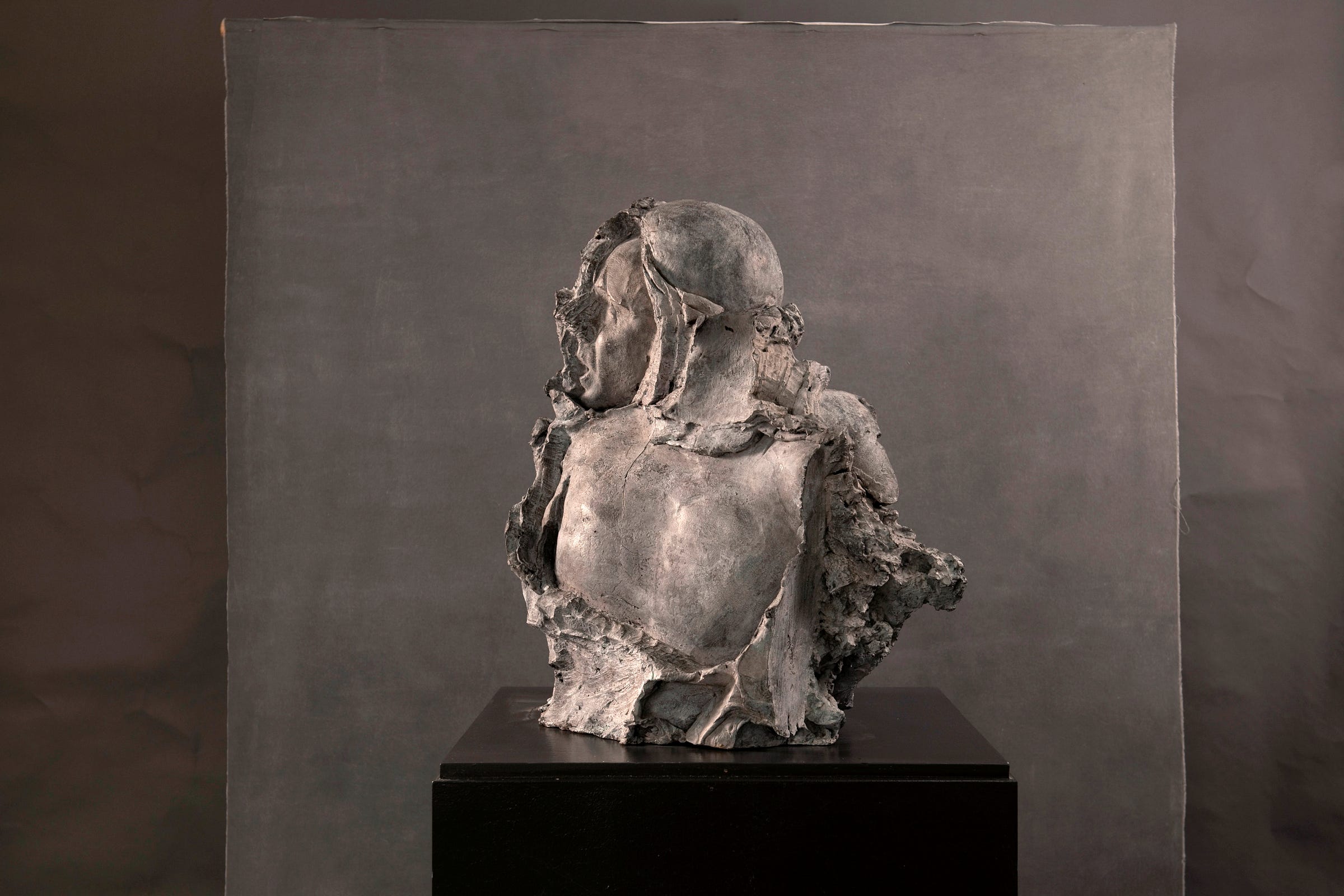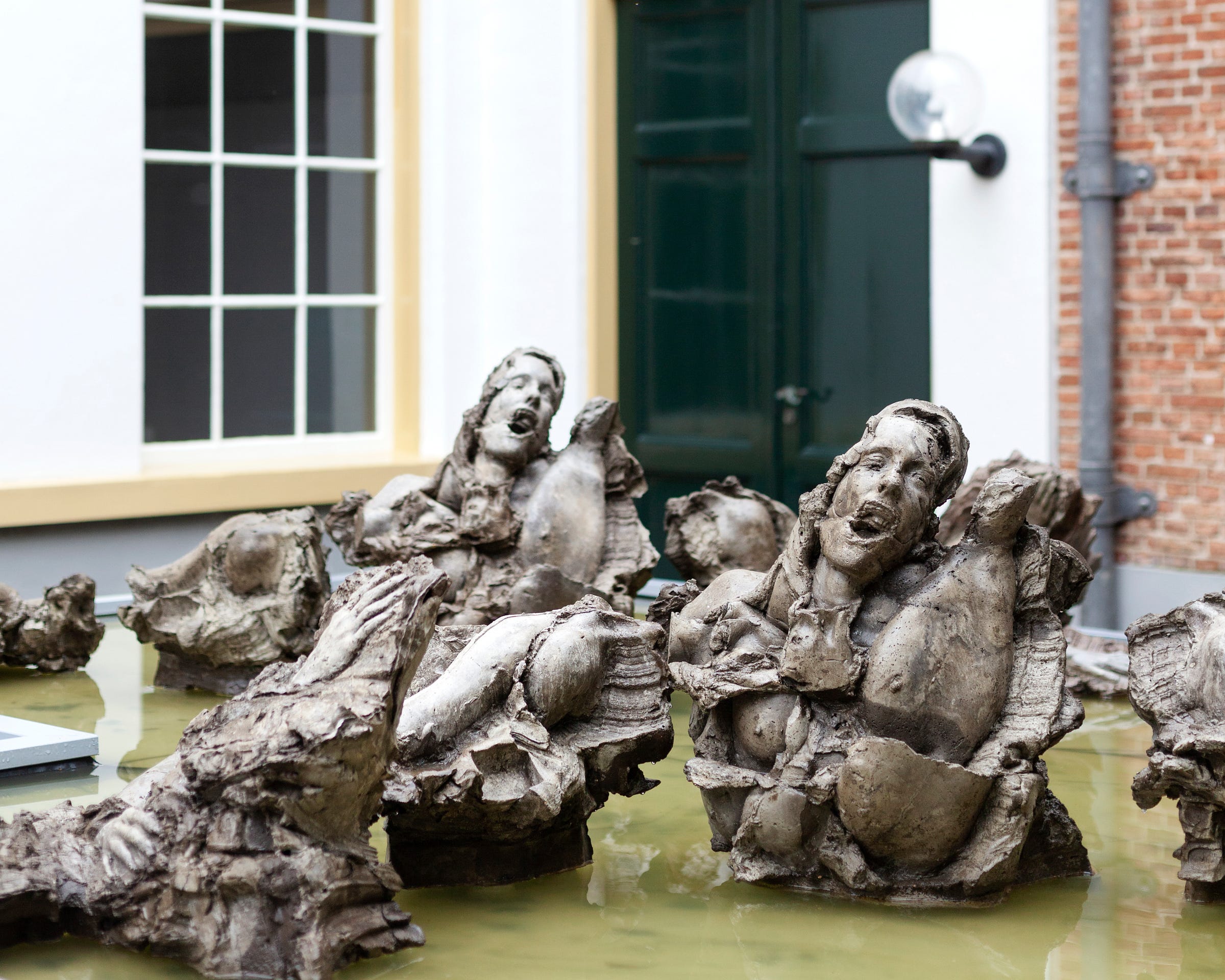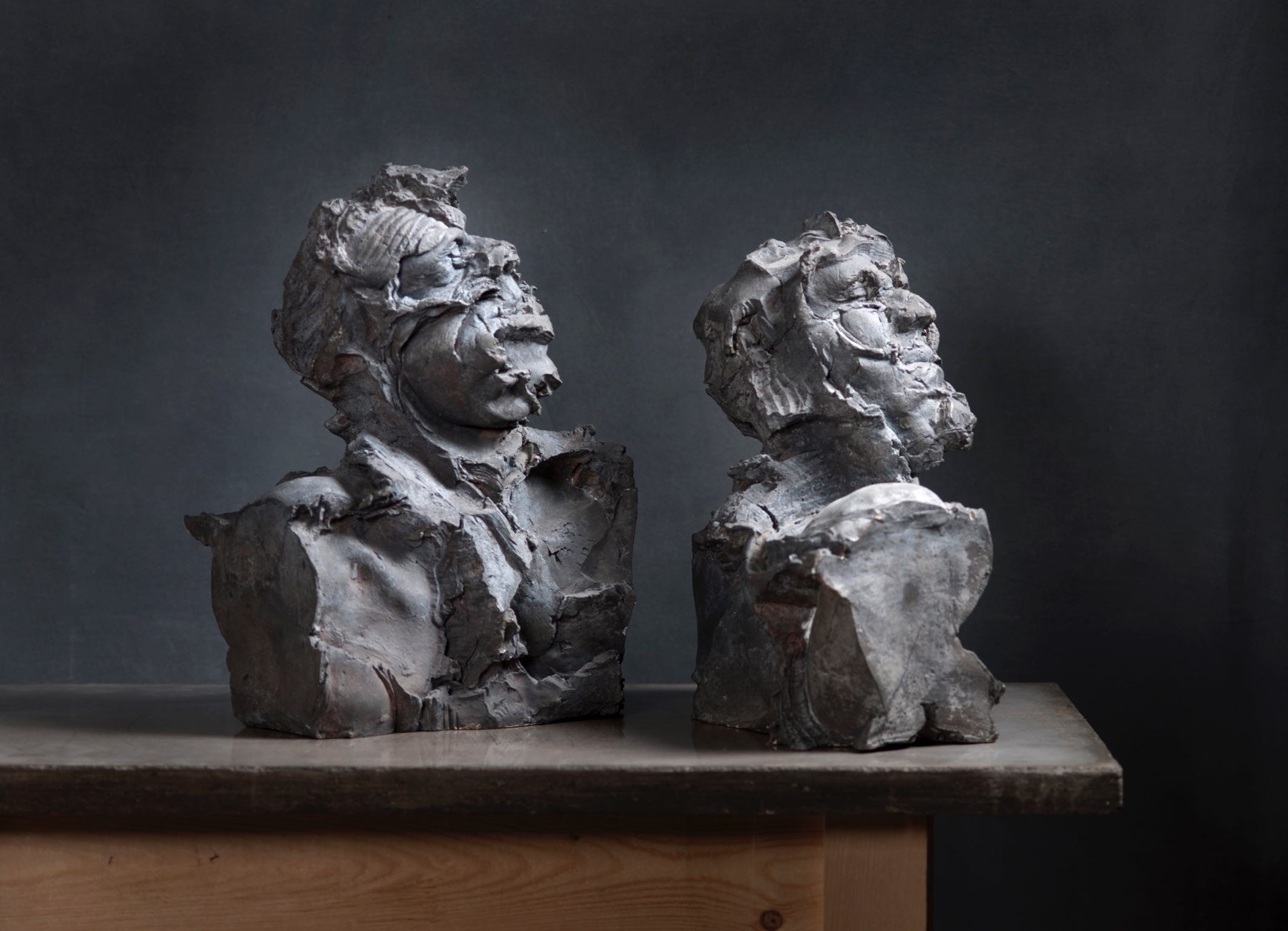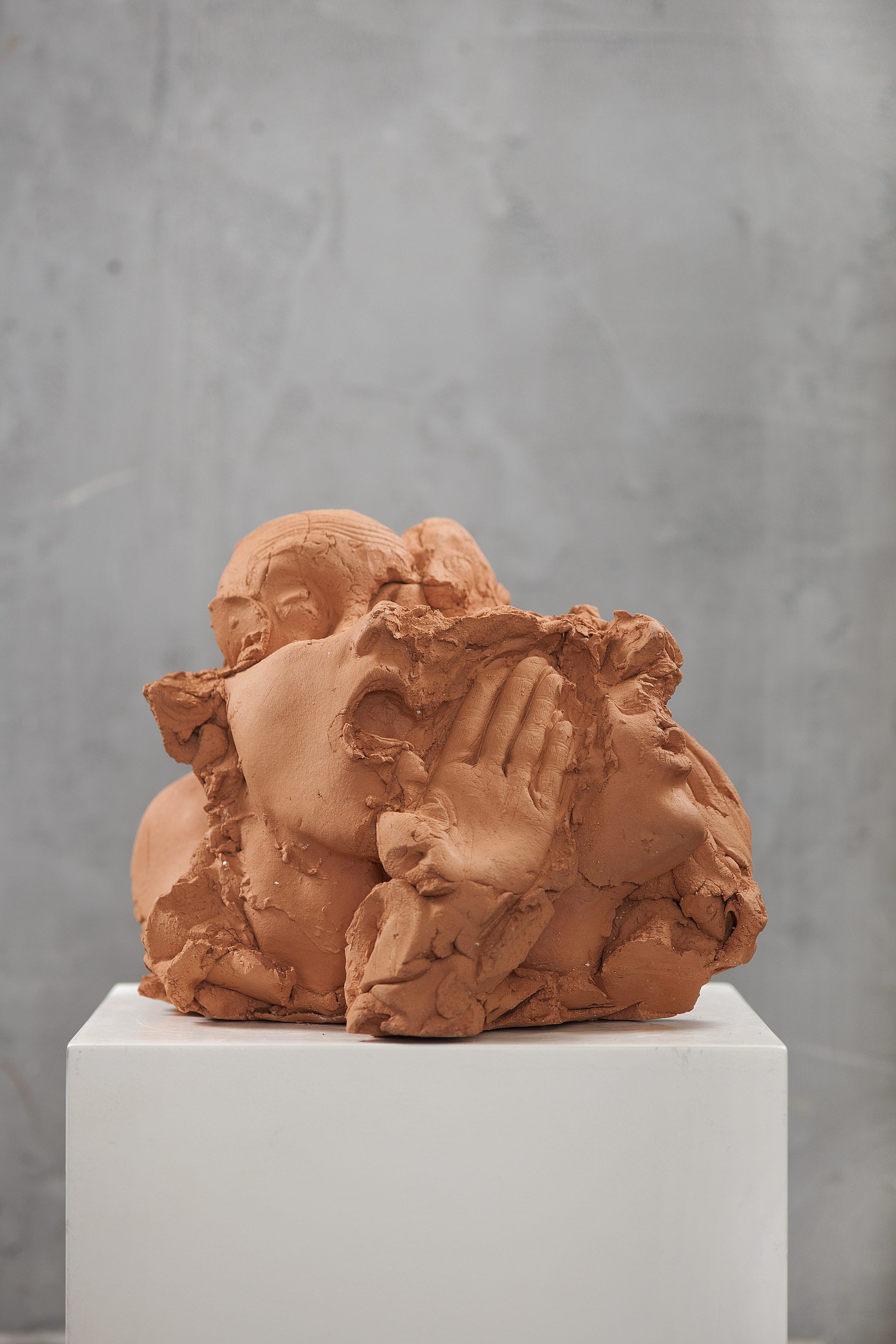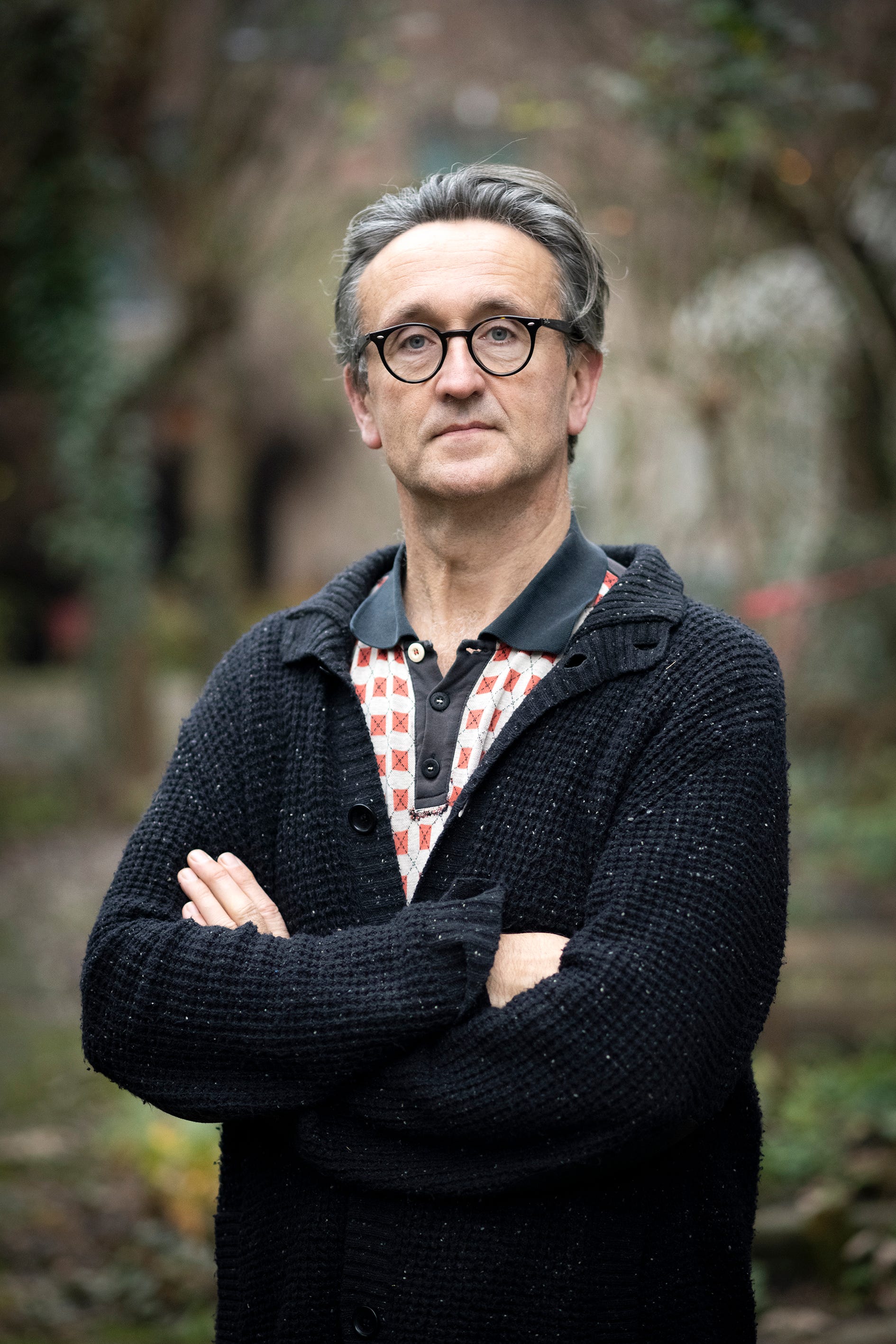Time Caught In The Act
A conversation with Tarantula: Authors And Art's Inspiration for April, Koen de Vries
It could be said that the sculptor Koen de Vries and I know each other since the early 90’s when we were both involved in a local theatre project. We haven’t seen or spoken to each other very often since then, so it was great to do this interview for Tarantula: Authors and Art together!
Koen had invited me to his studio on the first floor of an old school building (if you are a regular reader of Tarantula posts; also a school building in Leiden, The Netherlands, but not the same as Eva de Visser’s building). Koen later explained to me that he had a different working place on the ground floor before, where he could make much larger statues than he can do now. Because work of that size could not be carried down the stairs, he was forced to make different, smaller sculptures; little portrait busts. Let me first take you with me inside this old class room that is now Koen’s studio.
The gate keeper
To the left of the entrance, there is a sculpted bust and a few rock forms, placed on eye level. The pieces cannot NOT catch your eye and you can’t help but gaze at them. The face with the open mouth is especially intriguing, as are the rock shapes in which you can discover some body parts. The head has a real roughness about it which causes the light to change the image all the time. If you walk closer you’ll see the face from a different angle. One step to the left and another face appears, one step back and another shadow changes the face … The multi faced man with his scattered body parts is the gate keeper of Koen’s domain.
I knocked, I entered and was greeted with a nice smell of food and a warm welcome: “Hello Miranda!” “Hello Koen, how are you!?”
Time consuming life
We chatted a bit about the things I do lately and Koen commented that even though he likes the kind of things I do, he chooses to not be involved in any social events or voluntary works. He needs to cut those off because he wants to get into his studio. No time to lose! Already so much time is spent on ‘other than art things’. In his studio, he can be alone and renew and reinvent himself. It is important for him to be freed from the roles he plays in the ‘normal’ life in order to see the world as it is and to find out what needs to be told.
Koen mentions Max Beckmann, the German expressionistic painter (1884-1950). In his paintings Beckmann shows a version of everyday life in which the classic Greek heroes and gods play their respective role. The gods, Koen says, are like the directors of the play. “It is interesting to tune in. To try to get into a scene and to try to understand what is exactly happening in there. In every person’s life there are many things happening and I try to get the essence of what is happening.” “I try to look at people while they are playing their roles and being really engaged in this play. At the same time I feel they are playing out their story within a bigger story.”
Tarantula: Authors And Art: What is the relation of Max Beckmann’s work with your sculptures?
Koen de Vries: Well, I try to capture the little stories of one’s life in a sculpture. You can walk around a sculpture, no you have to walk around it, to see it from every angle. And every angle tells a different story. Where you start, your association starts. Where the association starts, your story for that moment also starts. If you start somewhere else there is another story beginning. It is a lengthy process of walking around, looking, accepting, discarding, changing and following the stories that form in your head. I make an effort to make this time as interesting as possible! Actually, I am trying to impose time on to something that is motionless.
That sounds interesting, can you tell me more?
You can maybe compare it best with animation. An motion film is also a series of images. Maybe you know these little ‘thumb books’? They are called ‘Daumen kino’ in German, ‘flip books’ in English. Well, something like that. It is funny: I recently remembered that I made my first photos with the flickering light of a stroboscope. I made five photos in one negative. That was also this attempt to get motion into one thing. A part of my work is optical art. I think opt art itself is not so interesting, but I am really interested in how you can show movement in a painting or a sculpture and get a glimpse of time in it.
When did this interest in photography become the art you make now?
I don’t know exactly. Photography changed our way of looking: details are made sharp with flashlight and we see blurriness as a result of non-sharpness or a moving object. Frame by frame disclosure began with photography, and it is this invention that resembles my technique and has allowed me to use the iconography of photography in three-dimensional works such as my sculptures. I once used structure as the surface of a portrait bust and noticed that the passing sun created shadows that changed the character I was modelling. So you could say this was the seed that was planted in my brain, but the translation of photography and motion film into clay got only really started in my most recent style.
Did you start making this kind of work during art school?
No, I was making portraits before I was an art school student, but lost my enthusiasm during that time. I tried to follow in the footsteps of Jean Tinguely, the Swiss painter and sculptor who made kinetic art (known for the machinery next to The Centre Pompidou). In art school, I was being professionalized and that almost killed my love for portrait busts.
But your enthusiasm returned!
Yes, it returned because I realized that I didn’t want to copy. I want to be on the look-out for things that can be found. I like the more ‘oracle way’ of making art. When you don’t know in advance what the outcome will be, but you are open to being surprised. I am not interested in simply illustrating your thoughts.
You used to make large sculptures but since you started working in this studio two years ago, you’ve been making smaller pieces.
I had to renew myself. [Koen stands up and walks over to a shelf to show me a clay sculpting that still needed to be baked.] This is a self-portrait that depicts the process of what was going on with me. I went back in time and I tried to capture he moment of transition. This portrait still resembles a normal human face with all of its parts in place, but it is a little rougher. I thought it was amusing to make my portrait with two pairs of glasses; one for looking far away and one for reading (the past). In a way I am looking back to look forward.
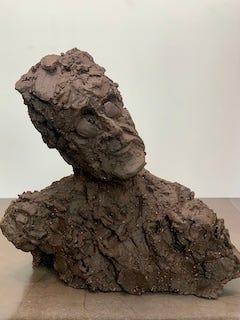
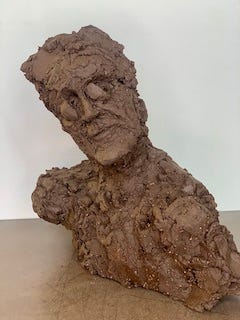
By changing your studio, you were forced to rethink everything you were doing until then?
For over ten years, I have been making bigger sculptures in bronze, which has been amazing and very satisfying, but also very expensive. I really had to work a lot in the dualistic world to make this happening. And as I mentioned earlier, there isn’t enough time left for my art if I have to spend too much time on all of my other roles and responsibilities in life (work, family, social events).
Do you miss making your bigger pieces?
What I am missing is my style and the way of communicating I had developed. But I like these little sketches I make now! They are like chess pieces but in a modernized version of the chess game. Nowadays, the role of the king and the queen is different. They are no longer the bosses, nor are they the central pieces of the game. I had to renew the roles of the chess pieces to meet the new world order, where people like Donald Trump and his hooligans who stormed the capitol are playing their roles. The pawns nowadays are also no longer a ‘one size fits all’ but they are all individual civilians struggling with their own lives.
I am interested in theatre and in the individual characters and their struggles. Not only am I interested in the people who might end up in the renewed chess game, but also in the figures who provide interesting ideas for me as a sculptor. For instance I am now trying to sculpt a philosopher who is incorrectly quoted. So he is being fucked, and his good name is being slandered. People understand a lot but they use it to support their own narrative and miss the point.
You are portraying people and try to tell their story within the bigger story? Are we back at the beginning of our interview where you mentioned Max Beckmann?
Well yes, it is a proposal. How do we see society and isn’t it time to reinvent things? Aren’t we thinking in an old fashioned way? If you ask a child how a train sounds, the child will still answers ‘Whoohoo!’ even though trains haven't made that sound in over fifty years.
I am trying to create a chess game as an homage to Max Beckmann. I am working on proposals for new chess figures to compose a Max Beckman set, because I believe in his point of view. It is the best way to understand human society.
You are clearly fascinated by people and you are trying to figure out what ‘makes them tick’. Are you only an observer or do you see yourself also as a creator who is creating something that might change the world?
Interesting question… I believe that the role of an artist in society is to show what is in the corner of your eye. The thing you can’t directly focus on. But once you focus on it, you can think about it, talk about it and learn from it. The role I see for myself is to point out some things that might be interesting to look at and might give you something to think about, to reflect on daily life, on how to look at each other, and how to interact and connect with each other.
Do we need your story with it, or is your sculpture enough? Are these little figures you make nowadays already drawing that attention you are talking about?
Mmm, I believe the story is always required in some way. That, in my opinion, is not exceptional. I think that is always the case with art. You always need the story about where and how to look at it. Kandinsky has an interesting thesis. He sees society as a triangle which moves in time in which the upper point there is reserved for god, below the god there is the genius and below the genius there are the people who understand the genius and so on. Everything is slowly descending to the bottom of the triangle, where people live their daily lives. We need the translations and we need time to let it all sink in. Over time, it slowly becomes our culture.
To wrap up this interview, can you explain in a few sentences the more technical process through which your work is created? You start with a drawing? Or with clay? How do you end up with a bronze statue?
I used moulds of a human face for my latest style. These moulds with parts of the human face are later pushed into the clay, leaving details of the face and other traces behind. In the oracle method I earlier described, a theatre persona starts to emerge that is captured playing the story in a time lapse. I like to cast the composition in bronze after that because I like the timelessness of the bronze - as a contrast to the limited time that was ‘caught in the act’ in my work.
Reflecting on the interview
Koen and I (both Dutch), conducted this interview in some sort of English (Dunglish). Koen had muttered something during the interview about how difficult it was for him to express himself in another language. But I am very happy we did it in this way because in Dutch he would have just poured out everything he had been thinking before, but in this way we had to look for the words together, which helped me get a grip on our conversation. Thank you Koen, for this effort! Thank you also for letting me and the readers of Tarantula: Authors and Art into your world.
To learn more about Koen de Vries you can visit his website koendevries.nl and Insta page echt.koendevries.nl





